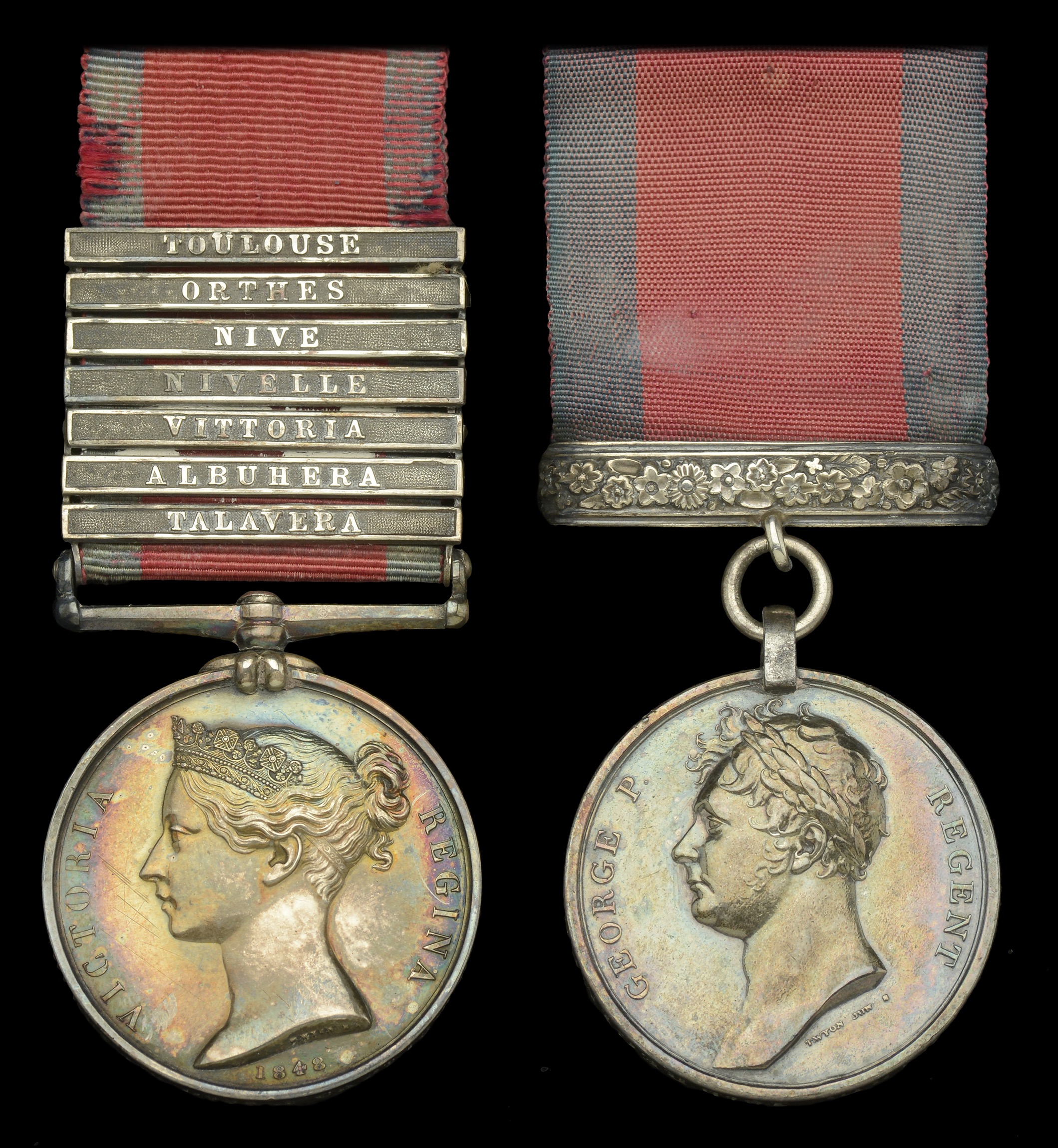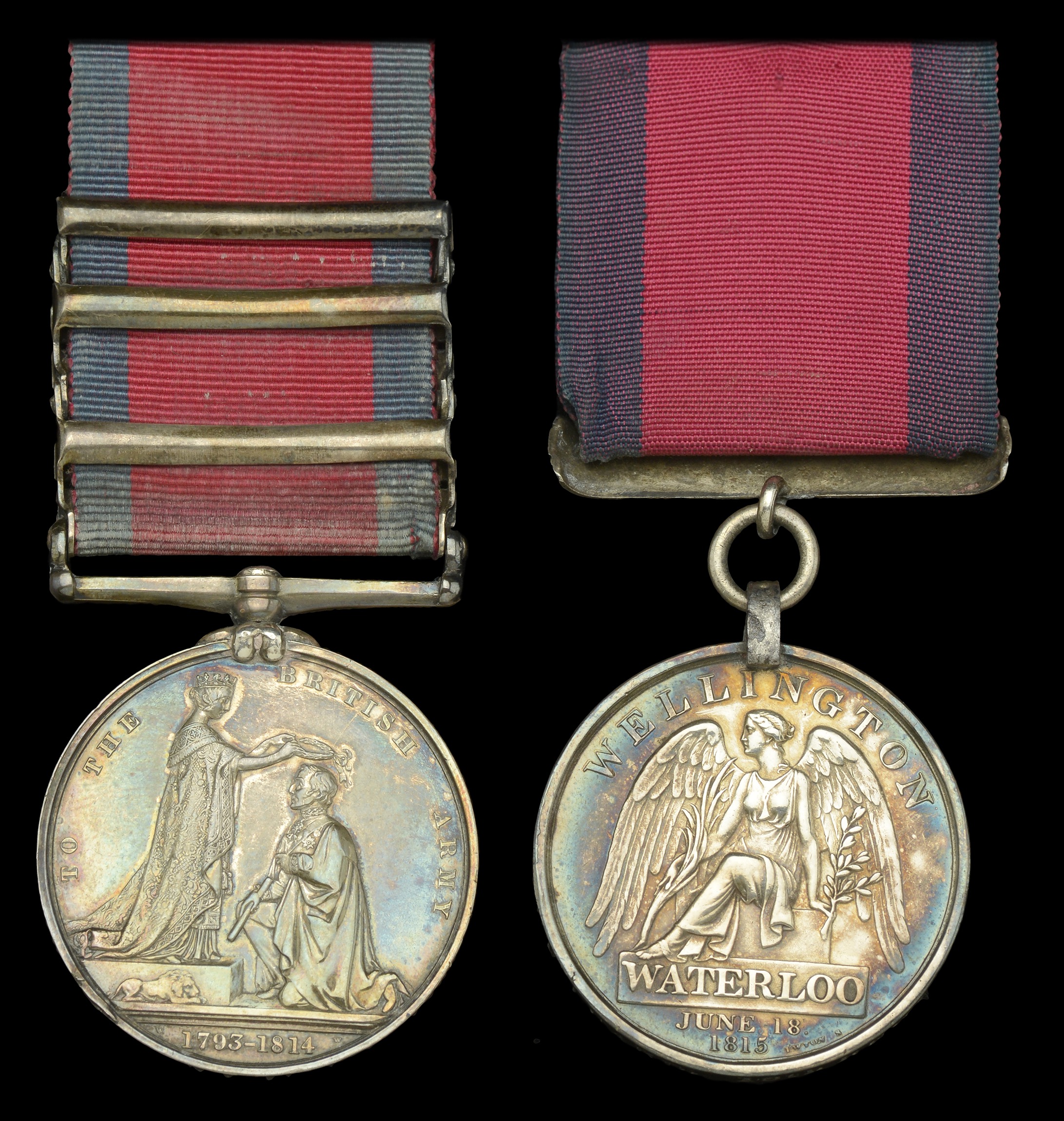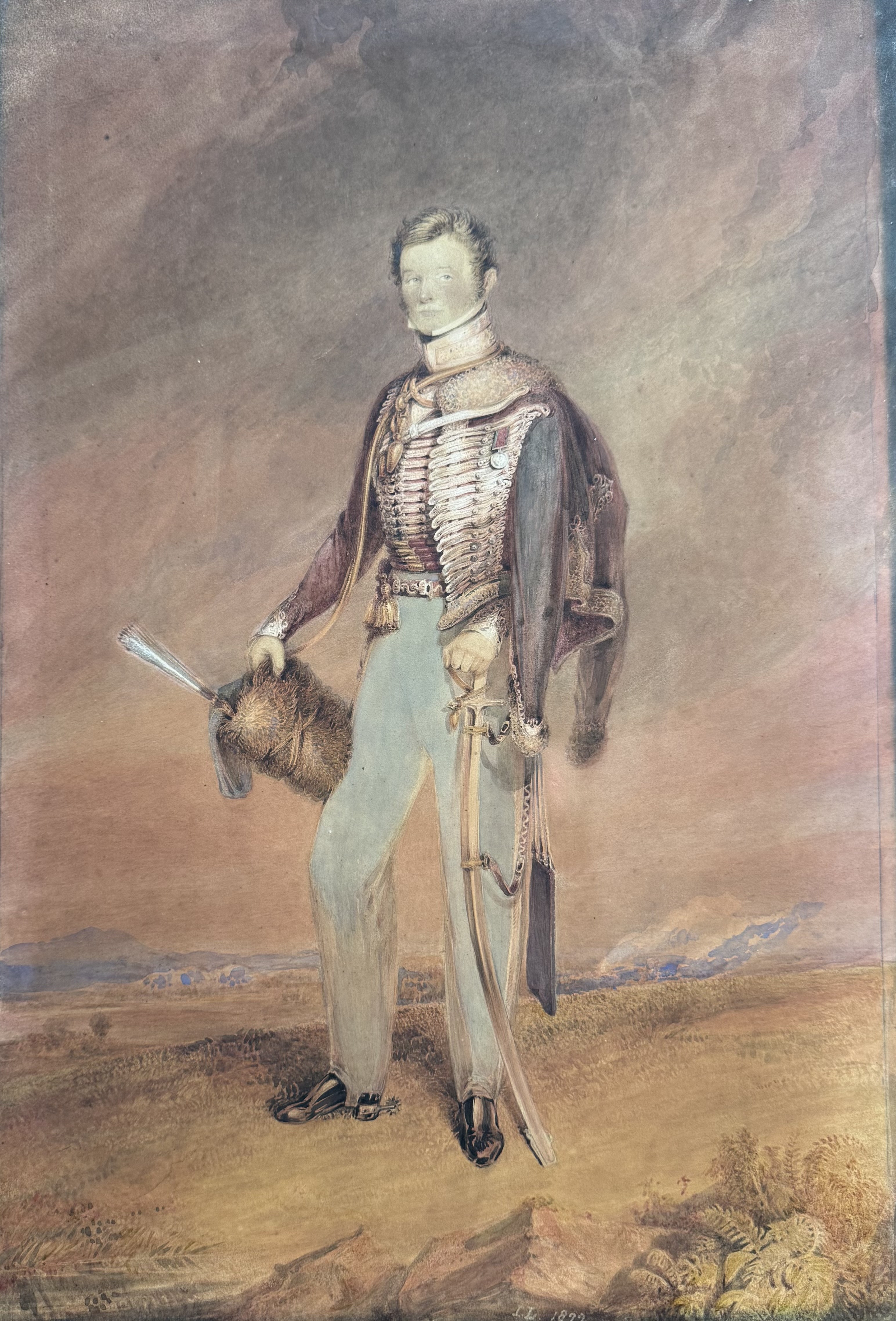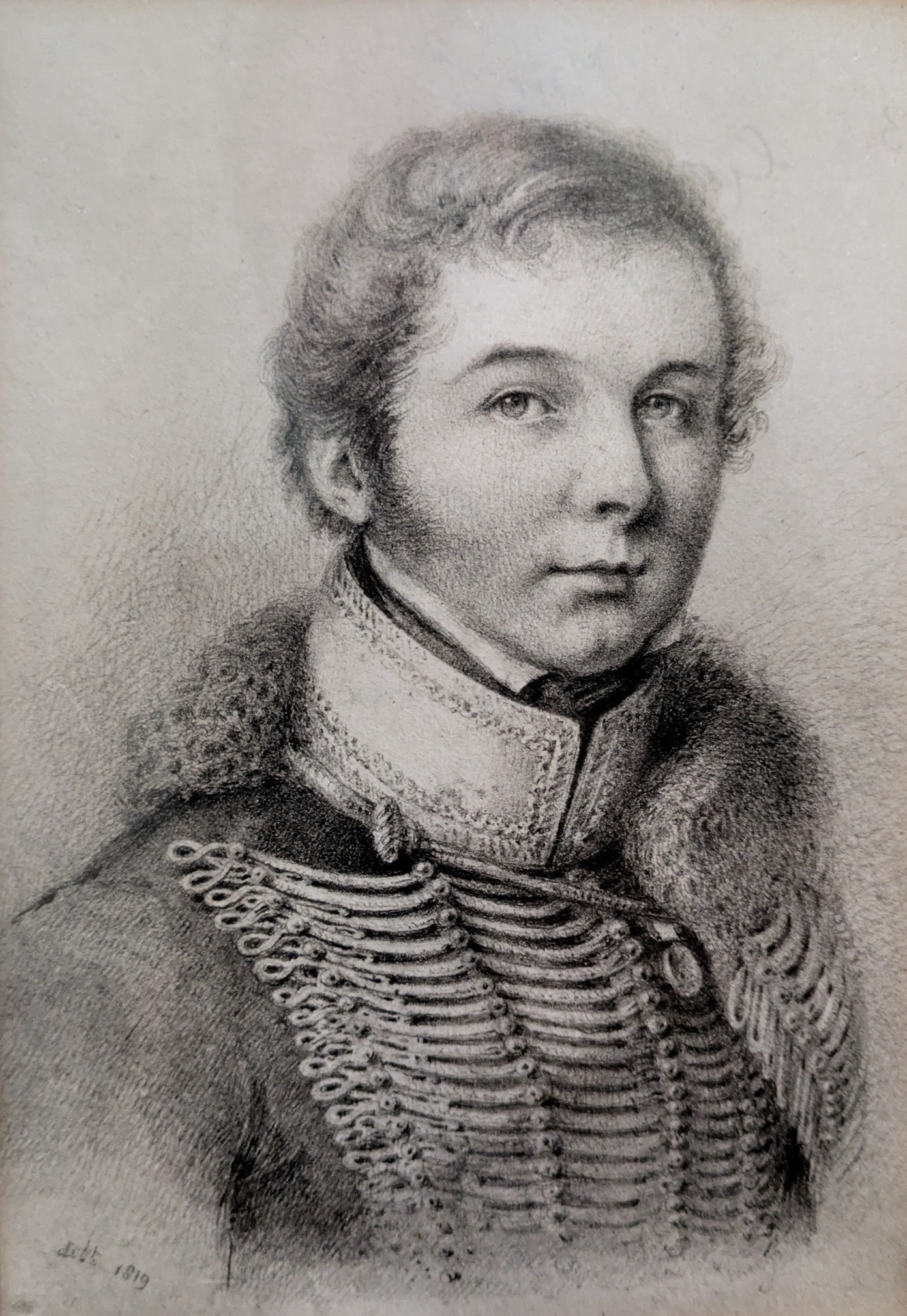100
The fine Peninsula and Waterloo pair awarded to Major George Luard, 18th Hussars, late 4th...
Bids do not include VAT, buyer’s premium or delivery.
By confirming your bid, you agree that you have read and accepted the-saleroom.com and the auctioneer's terms and conditions. Confirming your bid is a legally binding obligation to purchase and pay for the lot should your bid be successful.
Choose one of the quick bid options below:
Bids do not include VAT, buyer’s premium or delivery.
By confirming your bid, you agree that you have read and accepted the-saleroom.com and the auctioneer's terms and conditions. Confirming your bid is a legally binding obligation to purchase and pay for the lot should your bid be successful.
Military General Service 1793-1814, 7 clasps, Talavera, Albuhera, Vittoria, Nivelle, Nive, Orthes, Toulouse (Geo. Luard, Lieut. 4th Dgns. & Capt. 18th Hussars); Waterloo 1815 (Capt. George Luard, 18th Regiment Hussars.) fitted with original steel clip and contemporary decorative silver bar suspension, contained in an old fitted display case with leather label, the first with minor edge cut and light scratches to obverse field, otherwise toned, extremely fine, the second with light obverse dimpling from wear on uniform, very fine, the reverse about extremely fine, a most attractive pair (2) £10,000-£14,000
---
Provenance: By Order of a direct descendant who kindly provided the images.
George Luard was born in 1788, 3rd son of Peter John Luard, of Blyborough Hall, Lincolnshire, Captain in the 4th Dragoons, by Louisa, daughter of Charles Dalbiac, of Hungerford Park.
Appointed a Cornet in the 4th Dragoons on 24 June 1802, he was promoted Lieutenant on 5 February 1807. He exchanged as Captain to the 18th Hussars on 21 July 1813, and became Major on 27 September 1821.
Luard served in the Peninsula, France, and Flanders, from April 1809 to the end of the was; as Lieutenant in the 4th Dragoons at the battle of Talavera, in the retreat to the lines of Lisbon, occupation of them, actions of Pombal, Redinha, Condeixa, Campo Mayor, and Los Santos, battle of Albuhera, actions of Usagre, Fuente Guinaldo, and Aldea de Ponte; sieges of Ciudad Rodrigo, Badajoz, and Burgos, and battle of Vittoria; after which he served as Captain in the 18th Hussars, at the battle of Pyrenees in front of Pampeluna, battles of the Nivelle, the Nive, Orthes, Toulouse, and Waterloo, and with the Army of Occupation in France until August 1819.
Placed on half-pay as Major, 8 April 1826, he died in Ireland on 19 December 1847, leaving three daughters.
Action at Croix d’Orade, 8 April 1814
‘Early on the morning of the 8th April, 1814, the bridge was repaired, and Lord Wellington and his Staff passed over with the greater part of the army. Our brigade was now divided; the German Hussars went with the main body of the 4th Division, and the Regiment flanked the left brigade of the same division, marching in front of them towards St. Germas on the heights to the northward of the enemy's position, and here encountering part of the enemy.
"A great day for the 18th followed this affair," says Major Hughes, who continues:—"The enemy's advanced pickets were driven in, and the Regiment's patrols attacked the cavalry pickets of three regiments of the enemy's cavalry that were in the villages of St. Loup and St. Germas, etc.
From these pickets the Regiment killed and took some prisoners. Two of these regiments retired, and formed on the high road below the heights from St. Germas to Toulouse, and the other retired on the great road to Alby, keeping on our flank. On Lord Wellington arriving on the heights, he ordered me, with the Regiment, to drive them further off, on which we charged, drove them below the road; our flank being now much harassed by the fire of a detachment from the 5th Hussars, I halted and detached Captain Luard's troop, with Lieut. Dunkin, to attack them, and they drove them from the village on our flank, and here it was that poor Vivian's arm was broken by a carbine shot. I then attacked the two regiments (13th and 15th Chasseurs), who opposed us on the bridge over the Ers, and charged into them, taking a 200 prisoners, chiefly wounded, and an officer. My horse ‘Percy' was shot.
Our loss was only four killed, and one officer, Captain Croker, a gallant fellow, wounded. It was reckoned the best cavalry affair that has occurred, and all the praises which we have acquired have met my most sanguine expectations, and Lord Wellington has been most kind to me."
Of this gallant action, Captain Kennedy says:—" It was necessary to secure possession of the Bridge of Croix d'Aurade, on the river Ers, and over which we had to pass to attack Toulouse. This bridge was defended by three regiments of French Cavalry, amongst them the 22nd Chasseurs, and the Regiment was sent forward to attack the enemy's outposts, this being done by our riflemen dismounted, and afterwards to clear the village on our left - from whence we had been fired on - and this bridge."
Captain Luard writes:—"I was detached with a small party of the Regiment to the left, French cavalry having been heard of in that direction before our charges took place, when I fell in with Dunkin. French cavalry soon appeared, and brought us to a skirmish, but they did not press us beyond the border of a wood through which the road passed, by which I had advanced." Duperier (the Adjutant) was with this party, and having an oilskin cover on his fur cap at the time, was taken for a Frenchman, an awkward moment.
To return to Kennedy's account:—
It was about five o’clock in the evening, and, as we advanced, in full view of Lord Wellington, Sir Stapleton Cotton, and Marshal Beresford, all of whom were on a height and watching us (for at this time no other regiment was engaged), while on the opposite side, only a mile or so off, stood Soult and the whole French Army as spectators. The 1st King’s German Hussars were in support of us. In column of troops left in front, on went the Regiment, having Colonel Vivian in command, but before we reached the bridge he was wounded in the right arm, and had to be led away to the rear; but before leaving ordered Major Hughes to conduct the charge, and this was immediately done. The enemy received us with a volley of musquetry, but the Regiment was not to be driven by a musketry fire, and the charge sounded.
In an instant we were on to them, jammed them on the bridge, and sabred their front ranks, their rear ranks going off in disorder. In less than a minute, as it seemed, the whole column was routed, and we captured 120 of them with their horses. We pursued them at full gallop for nearly three miles in the very highest style, almost to the gates of Toulouse. The ranks of the French were so close together, that had we had Artillery there would have been a terrible butchery, but they all got off the road, which was broad and straight, unmasking their guns in so doing, and we were ordered by Sir Stapleton Cotton to retire, but reformed on the bridge, which we guarded. Lord Wellington was in the greatest delight all the time, and exclaimed "Well done, the Eighteenth. By God, well done."
Besides Colonel Vivian, Captain Croker was the only
officer wounded. It happened to the latter officer that his mare, carrying him several yards in advance in advance of his Hussars, he was borne into the enemy's ranks, when he received a severe sabre cut on his face; he French Dragoon who wounded him was immediately after sabred by Sergeant-Major Black. In our retirement we lost two horses killed, two wounded, and one Hussar wounded.’ (Memoirs of the Eighteenth Hussars, Colonel Harold Malet, refers).
Waterloo, in command of the centre squadron of the 18th Hussars
In the aftermath of the great battle, George Luard communicated the news to his mother:
‘In advance of the Field of Battle near Waterloo. 20 June
I lose no time, my dearest mother, in relieving you from the anxiety you must be having on our account after the late mos...
Military General Service 1793-1814, 7 clasps, Talavera, Albuhera, Vittoria, Nivelle, Nive, Orthes, Toulouse (Geo. Luard, Lieut. 4th Dgns. & Capt. 18th Hussars); Waterloo 1815 (Capt. George Luard, 18th Regiment Hussars.) fitted with original steel clip and contemporary decorative silver bar suspension, contained in an old fitted display case with leather label, the first with minor edge cut and light scratches to obverse field, otherwise toned, extremely fine, the second with light obverse dimpling from wear on uniform, very fine, the reverse about extremely fine, a most attractive pair (2) £10,000-£14,000
---
Provenance: By Order of a direct descendant who kindly provided the images.
George Luard was born in 1788, 3rd son of Peter John Luard, of Blyborough Hall, Lincolnshire, Captain in the 4th Dragoons, by Louisa, daughter of Charles Dalbiac, of Hungerford Park.
Appointed a Cornet in the 4th Dragoons on 24 June 1802, he was promoted Lieutenant on 5 February 1807. He exchanged as Captain to the 18th Hussars on 21 July 1813, and became Major on 27 September 1821.
Luard served in the Peninsula, France, and Flanders, from April 1809 to the end of the was; as Lieutenant in the 4th Dragoons at the battle of Talavera, in the retreat to the lines of Lisbon, occupation of them, actions of Pombal, Redinha, Condeixa, Campo Mayor, and Los Santos, battle of Albuhera, actions of Usagre, Fuente Guinaldo, and Aldea de Ponte; sieges of Ciudad Rodrigo, Badajoz, and Burgos, and battle of Vittoria; after which he served as Captain in the 18th Hussars, at the battle of Pyrenees in front of Pampeluna, battles of the Nivelle, the Nive, Orthes, Toulouse, and Waterloo, and with the Army of Occupation in France until August 1819.
Placed on half-pay as Major, 8 April 1826, he died in Ireland on 19 December 1847, leaving three daughters.
Action at Croix d’Orade, 8 April 1814
‘Early on the morning of the 8th April, 1814, the bridge was repaired, and Lord Wellington and his Staff passed over with the greater part of the army. Our brigade was now divided; the German Hussars went with the main body of the 4th Division, and the Regiment flanked the left brigade of the same division, marching in front of them towards St. Germas on the heights to the northward of the enemy's position, and here encountering part of the enemy.
"A great day for the 18th followed this affair," says Major Hughes, who continues:—"The enemy's advanced pickets were driven in, and the Regiment's patrols attacked the cavalry pickets of three regiments of the enemy's cavalry that were in the villages of St. Loup and St. Germas, etc.
From these pickets the Regiment killed and took some prisoners. Two of these regiments retired, and formed on the high road below the heights from St. Germas to Toulouse, and the other retired on the great road to Alby, keeping on our flank. On Lord Wellington arriving on the heights, he ordered me, with the Regiment, to drive them further off, on which we charged, drove them below the road; our flank being now much harassed by the fire of a detachment from the 5th Hussars, I halted and detached Captain Luard's troop, with Lieut. Dunkin, to attack them, and they drove them from the village on our flank, and here it was that poor Vivian's arm was broken by a carbine shot. I then attacked the two regiments (13th and 15th Chasseurs), who opposed us on the bridge over the Ers, and charged into them, taking a 200 prisoners, chiefly wounded, and an officer. My horse ‘Percy' was shot.
Our loss was only four killed, and one officer, Captain Croker, a gallant fellow, wounded. It was reckoned the best cavalry affair that has occurred, and all the praises which we have acquired have met my most sanguine expectations, and Lord Wellington has been most kind to me."
Of this gallant action, Captain Kennedy says:—" It was necessary to secure possession of the Bridge of Croix d'Aurade, on the river Ers, and over which we had to pass to attack Toulouse. This bridge was defended by three regiments of French Cavalry, amongst them the 22nd Chasseurs, and the Regiment was sent forward to attack the enemy's outposts, this being done by our riflemen dismounted, and afterwards to clear the village on our left - from whence we had been fired on - and this bridge."
Captain Luard writes:—"I was detached with a small party of the Regiment to the left, French cavalry having been heard of in that direction before our charges took place, when I fell in with Dunkin. French cavalry soon appeared, and brought us to a skirmish, but they did not press us beyond the border of a wood through which the road passed, by which I had advanced." Duperier (the Adjutant) was with this party, and having an oilskin cover on his fur cap at the time, was taken for a Frenchman, an awkward moment.
To return to Kennedy's account:—
It was about five o’clock in the evening, and, as we advanced, in full view of Lord Wellington, Sir Stapleton Cotton, and Marshal Beresford, all of whom were on a height and watching us (for at this time no other regiment was engaged), while on the opposite side, only a mile or so off, stood Soult and the whole French Army as spectators. The 1st King’s German Hussars were in support of us. In column of troops left in front, on went the Regiment, having Colonel Vivian in command, but before we reached the bridge he was wounded in the right arm, and had to be led away to the rear; but before leaving ordered Major Hughes to conduct the charge, and this was immediately done. The enemy received us with a volley of musquetry, but the Regiment was not to be driven by a musketry fire, and the charge sounded.
In an instant we were on to them, jammed them on the bridge, and sabred their front ranks, their rear ranks going off in disorder. In less than a minute, as it seemed, the whole column was routed, and we captured 120 of them with their horses. We pursued them at full gallop for nearly three miles in the very highest style, almost to the gates of Toulouse. The ranks of the French were so close together, that had we had Artillery there would have been a terrible butchery, but they all got off the road, which was broad and straight, unmasking their guns in so doing, and we were ordered by Sir Stapleton Cotton to retire, but reformed on the bridge, which we guarded. Lord Wellington was in the greatest delight all the time, and exclaimed "Well done, the Eighteenth. By God, well done."
Besides Colonel Vivian, Captain Croker was the only
officer wounded. It happened to the latter officer that his mare, carrying him several yards in advance in advance of his Hussars, he was borne into the enemy's ranks, when he received a severe sabre cut on his face; he French Dragoon who wounded him was immediately after sabred by Sergeant-Major Black. In our retirement we lost two horses killed, two wounded, and one Hussar wounded.’ (Memoirs of the Eighteenth Hussars, Colonel Harold Malet, refers).
Waterloo, in command of the centre squadron of the 18th Hussars
In the aftermath of the great battle, George Luard communicated the news to his mother:
‘In advance of the Field of Battle near Waterloo. 20 June
I lose no time, my dearest mother, in relieving you from the anxiety you must be having on our account after the late mos...
Orders, Decorations, Medals and Militaria
Sale Date(s)
Venue Address
General delivery information available from the auctioneer
If you are successful in purchasing lot/s being auctioned by us and opt for the item/s to be sent to you, we will use the following methods of shipment:
Within the UK
If you live within the UK, items will be despatched using Royal Mail Special Delivery. This service provides parcel tracking (via the Royal Mail website) and next weekday delivery (betwen 9am and 1pm). Items delivered within the UK are covered by our insurance company. Heavy and bulky lots will be sent by courier, in discussion with the client.
Outside of the UK
If the item/s being sent are worth under £1000 in total they are sent using Royal Mail’s Signed For International service. This ensures the item must be signed for when it is delivered.
If the item/s being sent are valued at over £1000 in total they will be sent using FedEx. This service allows next day delivery to customers in many parts of the US and parcels are fully trackable using the FedEx website.
Shipping Exceptions
Certain lots such as those containing glass or sharp implements, etc., may not be suitable for in-house shipping within or outside of the UK. Please contact Noonans with any queries.
Important Information
Auctioneer's Buyers Premium: 24% (+VAT)
There is an additional charge of 4.95% (+VAT/sales tax)




















